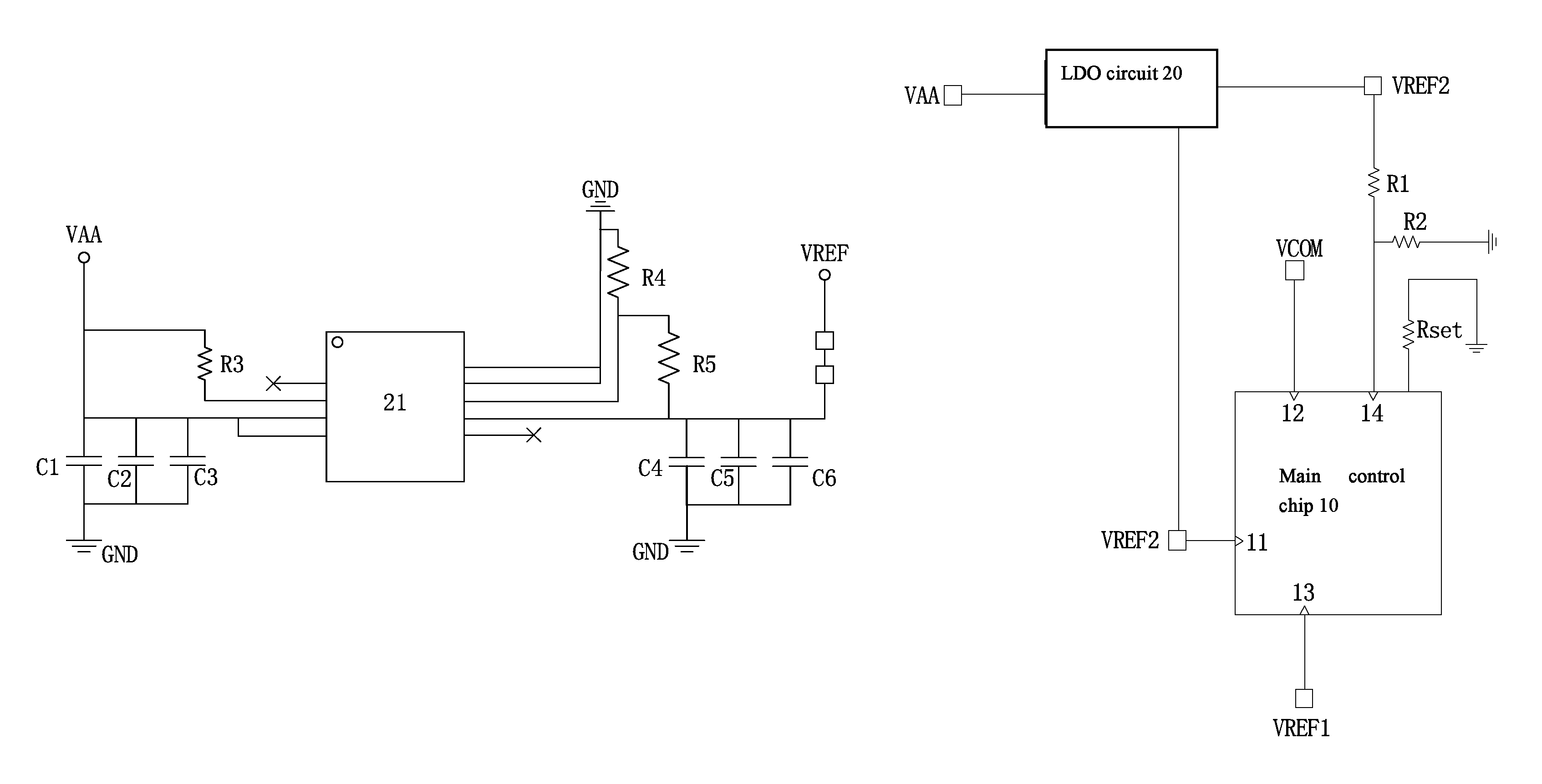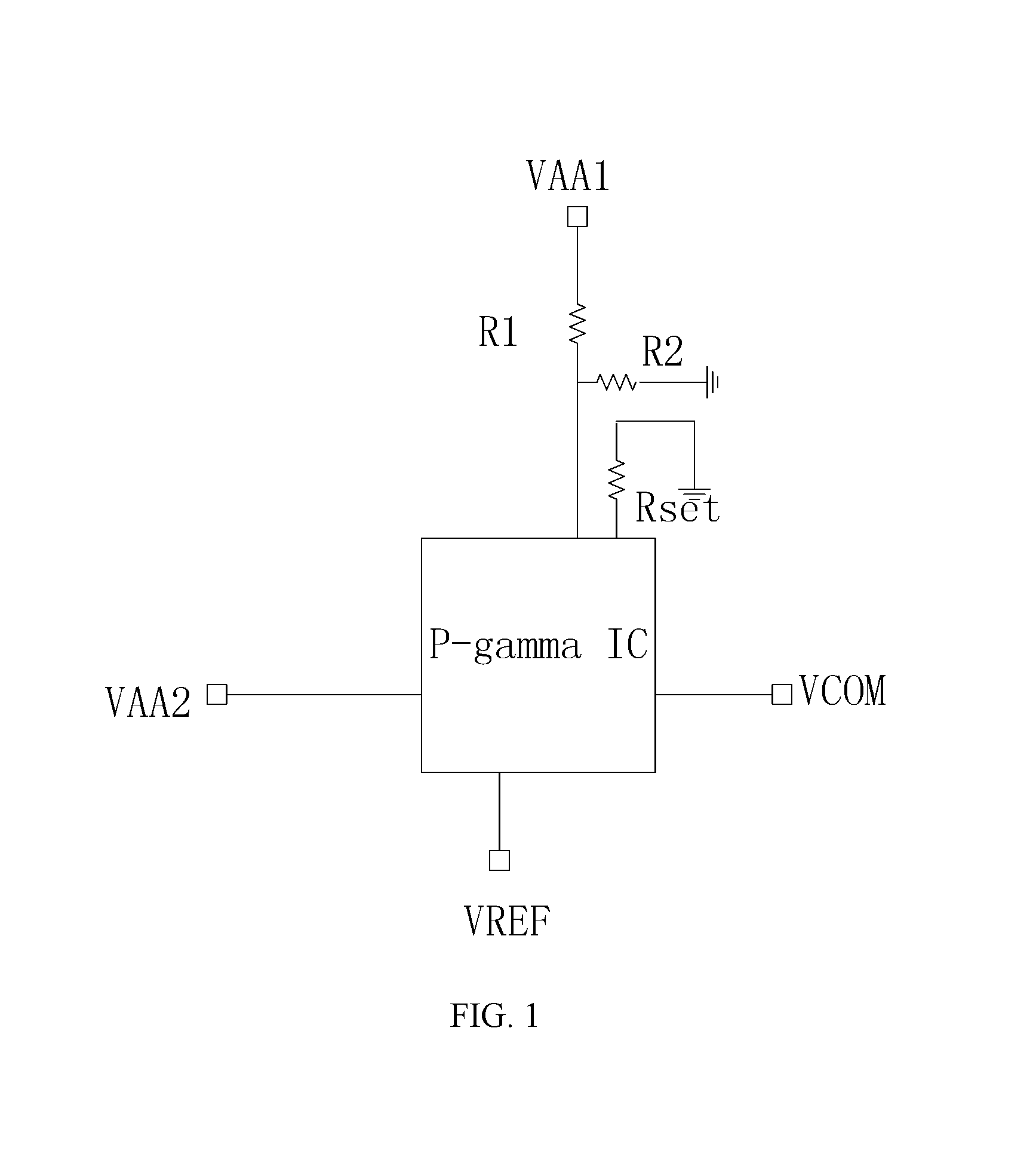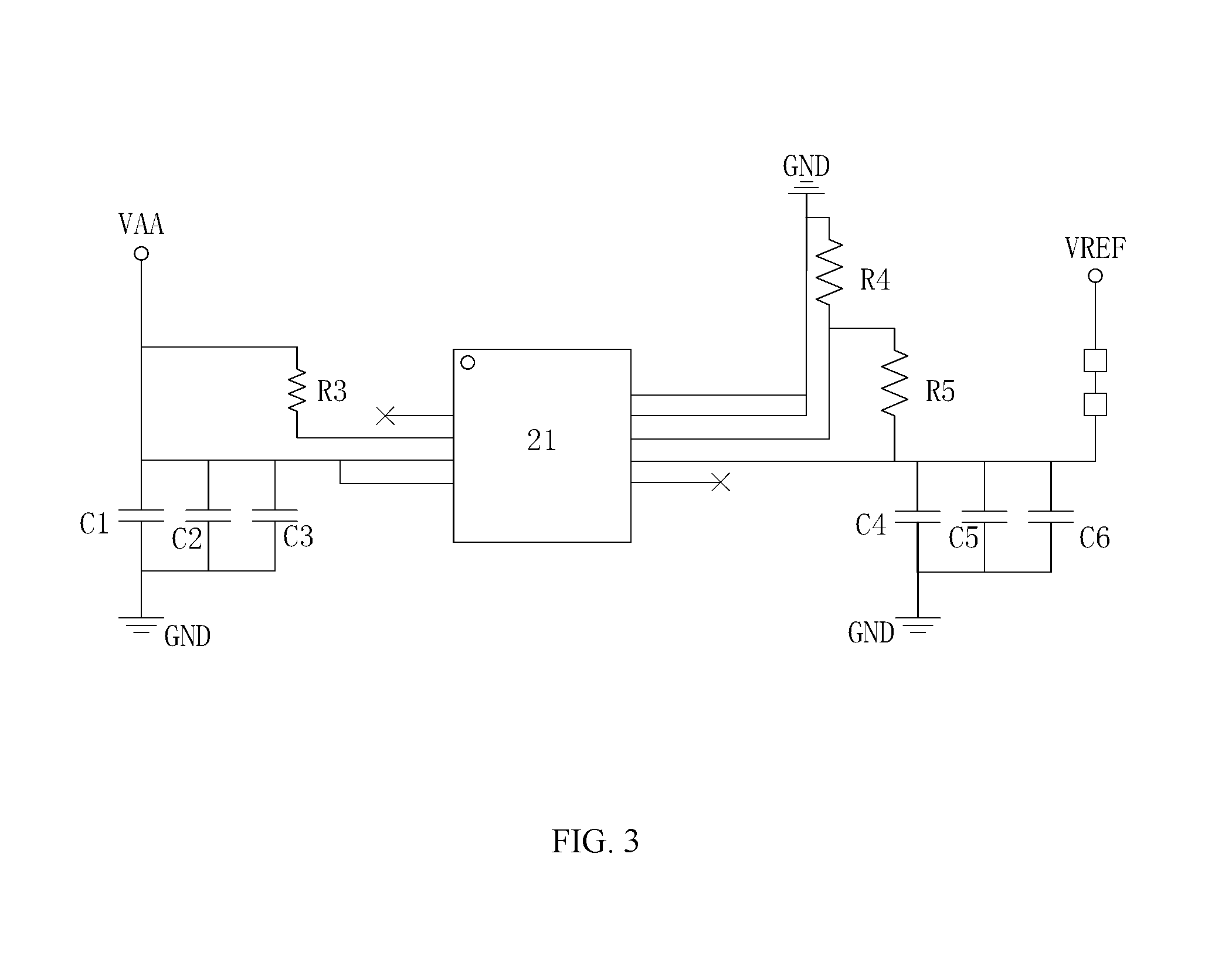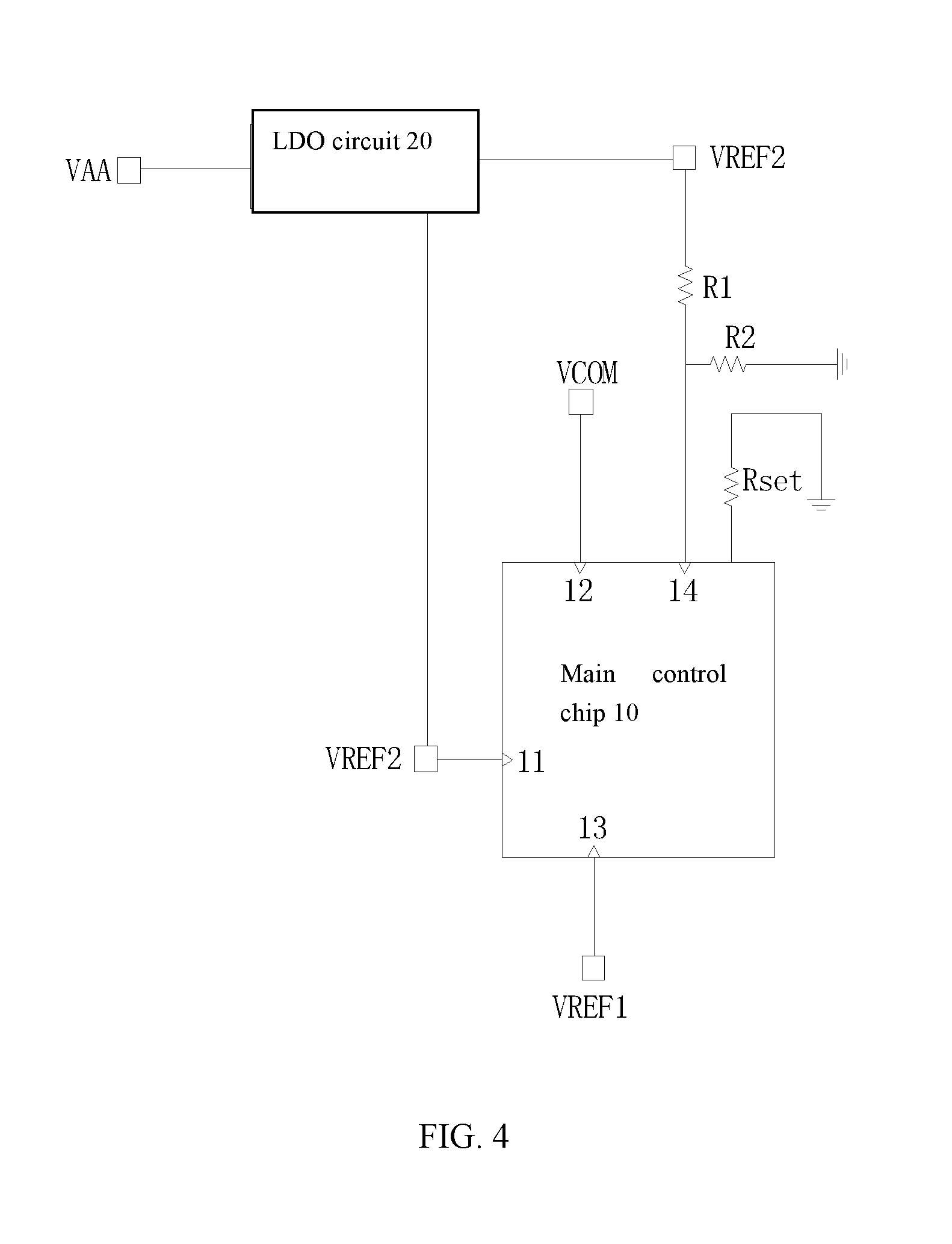Flicker control circuits for liquid crystal devices
Li , et al.
U.S. patent number 10,319,330 [Application Number 15/312,629] was granted by the patent office on 2019-06-11 for flicker control circuits for liquid crystal devices. This patent grant is currently assigned to Shenzhen China Star Optoelectronics Technology Co., Ltd. The grantee listed for this patent is Shenzhen China Star Optoelectronics Technology Co., Ltd.. Invention is credited to Xinhong Chen, Wenfang Li, Xianming Zhang.





| United States Patent | 10,319,330 |
| Li , et al. | June 11, 2019 |
Flicker control circuits for liquid crystal devices
Abstract
A flicker control circuit of liquid crystal devices (LCDs) includes a main control chip, a low differential voltage regulator (LDO) circuit, a first resistor, a second resistor, and a reset resistor. The main control chip includes an operational voltage input end, a common voltage output end, and a dividing reference voltage input end. The LDO circuit receives a voltage provided by an external power module and generates a dividing reference voltage in accordance with the received voltage. One end of the first resistor connects to the LDO circuit to receive the dividing reference voltage, and the other end of the first resistor connects to the dividing reference voltage input end. The flicker of the LCDs may be reduced such that the display performance of the LCDs may be enhanced.
| Inventors: | Li; Wenfang (Guangdong, CN), Zhang; Xianming (Guangdong, CN), Chen; Xinhong (Guangdong, CN) | ||||||||||
|---|---|---|---|---|---|---|---|---|---|---|---|
| Applicant: |
|
||||||||||
| Assignee: | Shenzhen China Star Optoelectronics
Technology Co., Ltd (Shenzhen, Guangdong, CN) |
||||||||||
| Family ID: | 57672211 | ||||||||||
| Appl. No.: | 15/312,629 | ||||||||||
| Filed: | September 27, 2016 | ||||||||||
| PCT Filed: | September 27, 2016 | ||||||||||
| PCT No.: | PCT/CN2016/100450 | ||||||||||
| 371(c)(1),(2),(4) Date: | November 19, 2016 | ||||||||||
| PCT Pub. No.: | WO2018/040165 | ||||||||||
| PCT Pub. Date: | March 08, 2018 |
Prior Publication Data
| Document Identifier | Publication Date | |
|---|---|---|
| US 20180182348 A1 | Jun 28, 2018 | |
Foreign Application Priority Data
| Aug 31, 2016 [CN] | 2016 1 0779826 | |||
| Current U.S. Class: | 1/1 |
| Current CPC Class: | G05F 3/08 (20130101); G09G 3/3696 (20130101); G09G 2320/0247 (20130101); G09G 2330/02 (20130101) |
| Current International Class: | G09G 3/36 (20060101); G05F 3/08 (20060101) |
References Cited [Referenced By]
U.S. Patent Documents
| 2010/0182300 | July 2010 | Kato |
| 2010/0194728 | August 2010 | Shingai |
Attorney, Agent or Firm: Cheng; Andrew C.
Claims
What is claimed is:
1. A flicker control circuit of liquid crystal display (LCD) device, comprising: a main control chip, a low differential voltage regulator (LDO) circuit, a first resistor, a second resistor, and a reset resistor; the main control chip comprises an operational voltage input end, a common voltage output end, and a dividing reference voltage input end; the LDO circuit receives a voltage provided by an external power module and generates a dividing reference voltage in accordance with the received voltage; one end of the first resistor connects to the LDO circuit to receive the dividing reference voltage, and the other end of the first resistor connects to the dividing reference voltage input end; one end of the second resistor connects to the other end of the first resistor, and the other end of the second resistor is electrically grounded; one end of the reset resistor connects to the main control chip, and the other end of the reset resistor is electrically grounded; the operational voltage input end receives the voltage provided by the external power module, and the voltage operates as the operational voltage of the main control chip, and the common voltage output end outputs a common voltage generated by the main control chip, and the common voltage and the dividing reference voltage are in a positive correlation, wherein the common voltage includes: VCOM=R2/(R1+R2)*[VREF2-VAA*R1*(n+1)/(2560*Rset)]; wherein VCOM indicates the common voltage, R1 indicates a resistance value of the first resistor, R2 indicates the resistance value of the second resistor, Rset indicates the resistance value of the reset resistor, VREF2 indicates the dividing reference voltage, VAA indicates the voltage provided by the external power module, and n is an integer in a range from 0 to 127, wherein a voltage drop of the LDO circuit is 0.3, and a current reaches 100 mA, wherein the LDO circuit comprises a voltage regulation chip, a first capacitor, a second capacitor, a third capacitor, a fourth capacitor, a fifth capacitor, a sixth capacitor, a third resistor, a fourth resistor, and a fifth resistor; and ends of the first capacitor, the second capacitor, the third capacitor, and the third resistor receive the voltage provided by the external power module, the other ends of the first capacitor, the second capacitor, the third capacitor, and the third resistor connect to the voltage regulation chip, ends of the fourth capacitor, the fifth capacitor, the sixth capacitor, and the fifth resistor connect to the first resistor and the voltage regulation chip, one end of the fourth resistor connects to the other end of the fifth resistor and to the voltage regulation chip, the first capacitor, the second capacitor, the third capacitor, the fourth capacitor, the fifth capacitor, the sixth capacitor, and the other end of the fourth resistor are electrically grounded.
2. The flicker control circuit of LCD as claimed in claim 1, wherein the common voltage and the dividing reference voltage increases or decreases along the same direction.
Description
BACKGROUND OF THE INVENTION
1. Field of the Invention
The present disclosure relates to liquid crystal display technology, and more particularly to a flicker control circuit of liquid crystal devices (LCDs).
2. Discussion of the Related Art
Currently, liquid crystal panels and control boards (CBs) may be separately shipped out in some business models. Under such circumstances, errors may exist due to the errors caused by the components, such as resistors or integrated chips (ICs), within the CB, the external operational voltages, and the difference between the reference voltages and the common voltage. Thus, the optical common voltage of a variety of CBs may be different for one liquid crystal panel. During the mass production, the auto gamma process is applied to various CBs to obtain the corresponding parameters for achieving the optical flicker control. The parameters are saved within the Flash memory with the liquid crystal panel. However, different CBs may be adopted randomly in the liquid crystal panels. The above errors, such as the operational voltage and the difference between the reference voltage and the common voltage, may cause flicker.
When the voltage span of the liquid crystals is close to the frequency of the response time of user eyes, users may observe the flicker due to the changed grayscale. The flicker may be worse when the voltage is asymmetrical due to the inversed polarity. In an example, when the optimal flicker is 20 after being applied with the auto gamma process, the flicker may reach 80 if a different CB is adopted. A control range of the operational voltage provided externally may be in a range from 15.3+ to -0.3V with the deviation equaling to 0.6V. FIG. 1 is a schematic view showing the P-GammaIC on one conventional CB, wherein the common voltage (VCOM) may be obtained by equation 1 below: VCOM=R2/(R1+R2)*[VAA1-VAA2*R1*(n+1)/2560*Rset], Equation 1:
Wherein VAA2 indicates the operational voltage of the Pgamma IC and the VAA2 is provided by an external power module, VAA1 indicates a partial voltage of the common voltage (VCOM) generated by the Pgamma IC and the VAA1 is also provided by one external power module, the V.sub.gamma indicates a Gamma reference voltage generated by Pgamma IC and the V.sub.gamma is provided to the common electrode of the display panel. The VAA1 and the VAA2 have different functions while the voltage values are the same and are provided by the same external power module.
In view of Equation 1, as the control ranges of VAA1 and VAA2 are in the range from 15.3+ to -0.3V with the deviation equaling to 0.6V, and thus the common voltage (VCOM) may be in great impact caused by the VAA1 and VAA2, that is, the flicker may be worse.
SUMMARY
To overcome the above problems, a flicker control circuit of LCDs is proposed to reduce the flicker of LCDs so as to enhance the display performance of LCDs.
In one aspect, a flicker control circuit of liquid crystal devices (LCDs) includes: a main control chip, a low differential voltage regulator (LDO) circuit, a first resistor, a second resistor, and a reset resistor; the main control chip includes an operational voltage input end, a common voltage output end, and a dividing reference voltage input end; the LDO circuit receives a voltage provided by an external power module and generates a dividing reference voltage in accordance with the received voltage; one end of the first resistor connects to the LDO circuit to receive the dividing reference voltage, and the other end of the first resistor connects to the dividing reference voltage input end; one end of the second resistor connects to the other end of the first resistor, and the other end of the second resistor is electrically grounded;
one end of the reset resistor connects to the main control chip, and the other end of the reset resistor is electrically grounded; the operational voltage input end receives the voltage provided by the external power module, and the voltage operates as the operational voltage of the main control chip, and the common voltage output end outputs a common voltage generated by the main control chip, and the common voltage and the dividing reference voltage are in a positive correlation.
Wherein the common voltage and the dividing reference voltage increases or decreases along the same direction.
Wherein the common voltage is: VCOM=R2/(R1+R2)*[VREF2-VAA*R1*(n+1)/(2560*Rset)];
wherein VCOM indicates the common voltage, R1 indicates a resistance value of the first resistor, R2 indicates the resistance value of the second resistor, Rset indicates the resistance value of the reset resistor, VREF2 indicates the dividing reference voltage, VAA indicates the voltage provided by the external power module, and n is an integer in a range from 0 to 127.
Wherein a voltage drop of the LDO circuit is 0.3, and a current reaches 100 mA.
Wherein the LDO circuit includes a voltage regulation chip, a first capacitor, a second capacitor, a third capacitor, a fourth capacitor, a fifth capacitor, a sixth capacitor, a third resistor, a fourth resistor, and a fifth resistor; and ends of the first capacitor, the second capacitor, the third capacitor, and the third resistor receive the voltage provided by the external power module, the other ends of the first capacitor, the second capacitor, the third capacitor, and the third resistor connect to the voltage regulation chip, ends of the fourth capacitor, the fifth capacitor, the sixth capacitor, and the fifth resistor connect to the first resistor and the voltage regulation chip, one end of the fourth resistor connects to the other end of the fifth resistor and to the voltage regulation chip, the first capacitor, the second capacitor, the third capacitor, the fourth capacitor, the fifth capacitor, the sixth capacitor, and the other end of the fourth resistor are electrically grounded.
In another aspect, a flicker control circuit of liquid crystal devices (LCDs) includes: a main control chip, a low differential voltage regulator (LDO) circuit, a first resistor, a second resistor, and a reset resistor; the main control chip includes an operational voltage input end, a common voltage output end, and a dividing reference voltage input end; the LDO circuit receives a voltage provided by an external power module and generates a dividing reference voltage in accordance with the received voltage; one end of the first resistor connects to the LDO circuit to receive the dividing reference voltage, and the other end of the first resistor connects to the dividing reference voltage input end; one end of the second resistor connects to the other end of the first resistor, and the other end of the second resistor is electrically grounded; one end of the reset resistor connects to the main control chip, and the other end of the reset resistor is electrically grounded; the operational voltage input end receives the generated dividing reference voltage operating as the operational voltage of the main control chip, and the common voltage output end outputs a common voltage generated by the main control chip, and the common voltage and the dividing reference voltage are in a positive correlation.
Wherein the common voltage and the dividing reference voltage increases or decreases along the same direction.
Wherein the common voltage is: VCOM=R2/(R1+R2)*[VREF2-VAA*R1*(n+1)/(2560*Rset)];
wherein VCOM indicates the common voltage, R1 indicates a resistance value of the first resistor, R2 indicates the resistance value of the second resistor, Rset indicates the resistance value of the reset resistor, VREF2 indicates the dividing reference voltage, VAA indicates the voltage provided by the external power module, and n is an integer in a range from 0 to 127.
Wherein a voltage drop of the LDO circuit is 0.3, and a current reaches 100 mA.
Wherein the LDO circuit includes a voltage regulation chip, a first capacitor, a second capacitor, a third capacitor, a fourth capacitor, a fifth capacitor, a sixth capacitor, a third resistor, a fourth resistor, and a fifth resistor; and ends of the first capacitor, the second capacitor, the third capacitor, and the third resistor receive the voltage provided by the external power module, the other ends of the first capacitor, the second capacitor, the third capacitor, and the third resistor connect to the voltage regulation chip, ends of the fourth capacitor, the fifth capacitor, the sixth capacitor, and the fifth resistor connect to the first resistor and the voltage regulation chip, one end of the fourth resistor connects to the other end of the fifth resistor and to the voltage regulation chip, the first capacitor, the second capacitor, the third capacitor, the fourth capacitor, the fifth capacitor, the sixth capacitor, and the other end of the fourth resistor are electrically grounded.
In view of the above, the partial voltage of the common voltage is changed to be the dividing reference voltage by the LDO circuit, such that the common voltage is affected by the dividing reference voltage. As the precision of the dividing reference voltage is higher, the precision of the common voltage is enhanced. In addition, as the common voltage may change in accordance with the dividing reference voltage along the same direction, the image flicker of the LCD may be reduced.
BRIEF DESCRIPTION OF THE DRAWINGS
Embodiments of the invention will now be described more fully hereinafter with reference to the accompanying drawings, in which embodiments of the invention are shown.
FIG. 1 is a schematic view showing the conventional flicker control circuit of LCDs.
FIG. 2 is a circuit diagram of the flicker control circuit of LCDs in accordance with one embodiment.
FIG. 3 is a circuit diagram of the LDO circuit of the flicker control circuit of LCDs in accordance with one embodiment.
FIG. 4 is a circuit diagram of the flicker control circuit of LCDs in accordance with another embodiment.
DETAILED DESCRIPTION OF THE EMBODIMENTS
Various example embodiments will now be described more fully with reference to the accompanying drawings in which some example embodiments are shown. In the drawings, the thicknesses of layers and regions may be exaggerated for clarity. In the following description, in order to avoid the known structure and/or function unnecessary detailed description of the concept of the invention result in confusion, well-known structures may be omitted and/or functions described in unnecessary detail.
FIG. 2 is a circuit diagram of the flicker control circuit of LCDs in accordance with one embodiment.
Referring to FIG. 2, the flicker control circuit includes a main control chip 10, a low differential voltage regulator (LDO) circuit 20, a first resistor (R1) connected to the main control chip 10, a second resistor (R2) connected to the main control chip 10, and a reset resistor (Rset). The main control chip 10 includes an operational voltage input end 11 for receiving an operation voltage (VAA) provided by an external power module, a common voltage output end 12 for outputting a common voltage (VCOM) to a common electrode of a display panel, a Gamma voltage output end 13 for outputting a Gamma reference voltage (VREF1) to a data driver of the display panel, and a dividing reference voltage input end 14 for receiving a dividing reference voltage (VREF2) inputted via the first resistor (R1). In the embodiment, the main control chip 10 may be a programmable Gamma correction buffer chip (P-GammaIC), but the present disclosure is not limited thereto.
One end of the LDO circuit 20 receives the operation voltage (VAA), and the other end of the LDO circuit 20 connects to the dividing reference voltage input end 14 via the first resistor (R1). One end of the second resistor (R2) connects between the first resistor (R1) and the dividing reference voltage input end 14, and the other end of the second resistor (R2) is electrically grounded. The LDO circuit 20 generates the dividing reference voltage (VREF2) in accordance with the operation voltage (VAA).
FIG. 3 is a circuit diagram of the LDO circuit of the flicker control circuit of LCDs in accordance with one embodiment. The LDO circuit 20 includes a voltage regulation chip 21, a first capacitor (C1), a second capacitor (C2), a third capacitor (C3), a fourth capacitor (C4), a fifth capacitor (C5), a sixth capacitor (C6), a third resistor (R3), a fourth resistor (R4), and a fifth resistor (R5).
Ends of the first capacitor (C1), the second capacitor (C2), the third capacitor (C3), and the third resistor (R3) receive the operation voltage (VAA), and the other ends of the first capacitor (C1), the second capacitor (C2), the third capacitor (C3), and the third resistor (R3) connect to the voltage regulation chip 21. Ends of the fourth capacitor (C4), the fifth capacitor (C5), the sixth capacitor (C6), and the fifth resistor (R5) connect to the first resistor (R1) and the voltage regulation chip 21. One end of the fourth resistor (R4) connects to the other end of the fifth resistor (R5) and to the voltage regulation chip 21. The capacitors (C1, C2, C3, C4, C5, and C6) and the other end of the fourth resistor (R4) connect to a grounding end (GND).
In view of FIGS. 2 and 3, the voltage drop of the LDO circuit 20 may be 0.3V, and the current may be 100 mA. At this moment, the common voltage (VCOM) may be: VCOM=R2/(R1+R2)*[VREF2-VAA*R1*(n+1)/(2560*RSET)], wherein n is an integer in a range from 0 to 127. The common voltage (VCOM) may be affected by the operation voltage (VAA) and the dividing reference voltage (VREF2). As the precision of the dividing reference voltage (VREF2) is higher than the precision of the operation voltage (VAA), the precision of the common voltage (VCOM) may be enhanced. In addition, as the common voltage (VCOM) may change in accordance with the dividing reference voltage (VREF2) along the same direction, the image flicker of the LCD may be reduced.
FIG. 4 is a circuit diagram of the flicker control circuit of LCDs in accordance with another embodiment.
Referring to FIG. 4, the difference between the flicker control circuit and that in FIG. 2 resides in that: the operational voltage input end 11 may also connect to the LDO circuit 20 to receive the dividing reference voltage (VREF2) operating as a power supply voltage of the main control chip 10. At this moment, the common voltage (VCOM) may be: VCOM=R2/(R1+R2)*[VREF2-VREF2*R1*(n+1)/(2560*RSET)], wherein n is an integer in a range from 0 to 127. The common voltage (VCOM) may be also affected by the dividing reference voltage (VREF2). As the precision of the dividing reference voltage (VREF2) is higher than the precision of the operation voltage (VAA), the precision of the common voltage (VCOM) may be enhanced. In addition, as the common voltage (VCOM) may change in accordance with the dividing reference voltage (VREF2) along the same direction, the image flicker of the LCD may be reduced.
In view of the above, the voltage drop of the LDO circuit 20 may be 0.3V, and the current may be 100 mA. In addition, the partial voltage of the common voltage (VCOM) may be the dividing reference voltage (VREF2) such that the common voltage (VCOM) may be affected by the dividing reference voltage (VREF2). As the precision of the dividing reference voltage (VREF2) is higher than the precision of the operation voltage (VAA), the precision of the common voltage (VCOM) may be enhanced. In addition, as the common voltage (VCOM) may change in accordance with the dividing reference voltage (VREF2) along the same direction, the image flicker of the LCD may be reduced.
It is believed that the present embodiments and their advantages will be understood from the foregoing description, and it will be apparent that various changes may be made thereto without departing from the spirit and scope of the invention or sacrificing all of its material advantages, the examples hereinbefore described merely being preferred or exemplary embodiments of the invention.
* * * * *
D00000

D00001

D00002

D00003

D00004

XML
uspto.report is an independent third-party trademark research tool that is not affiliated, endorsed, or sponsored by the United States Patent and Trademark Office (USPTO) or any other governmental organization. The information provided by uspto.report is based on publicly available data at the time of writing and is intended for informational purposes only.
While we strive to provide accurate and up-to-date information, we do not guarantee the accuracy, completeness, reliability, or suitability of the information displayed on this site. The use of this site is at your own risk. Any reliance you place on such information is therefore strictly at your own risk.
All official trademark data, including owner information, should be verified by visiting the official USPTO website at www.uspto.gov. This site is not intended to replace professional legal advice and should not be used as a substitute for consulting with a legal professional who is knowledgeable about trademark law.